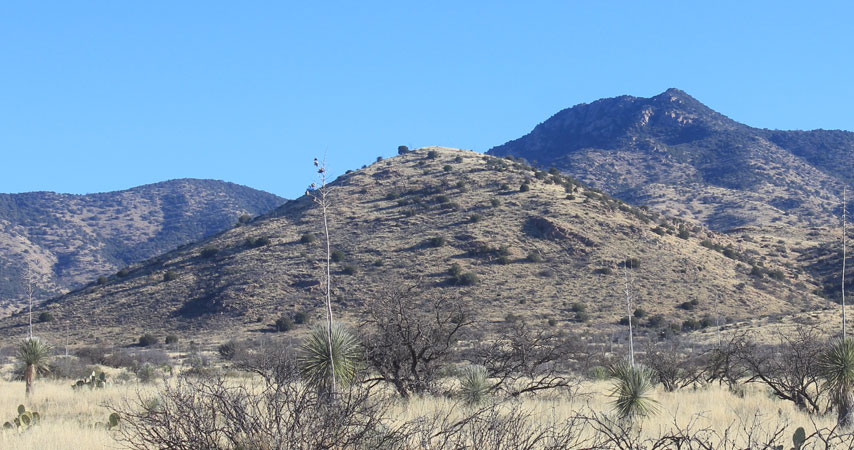 |
The U.S. Calvary vs the Apaches--the battle at KH Butte
 |
KH Butte is located on the southside of the Graham Mountains approximately 11 miles northwest of old Fort Grant. On October 2nd, 1881, there was a violent encounter here between several companies of U.S. Calvary and a group of Apaches that had broken out from the San Carlos Indian Reservation.
The battle was fought over a wide area, from the flats south of the butte, to the ridges beyond. Quite a bit of walking is involved to check out this site. The payoff is the chance to see some of the actual fighting positions used by both the army and the Apaches. Those positions are in the form of fortifications erected by the combatants of both sides.
The battle involved approximately 120 soldiers and perhaps 100 Apaches. It began around 3pm in the afternoon as the soldiers inspected the bodies of a telegraph repair crew found while the troopers were in pursuit of the Apaches. The four man crew had been sent out from Fort Grant to put back into operation the telegraph line that connected Fort Grant to Fort Thomas. Unaware of the Apache situation, the repairmen had not been prepared for an ambush.
This map from 1888 shows the location of the telegraph line and its relationship to KH Butte.
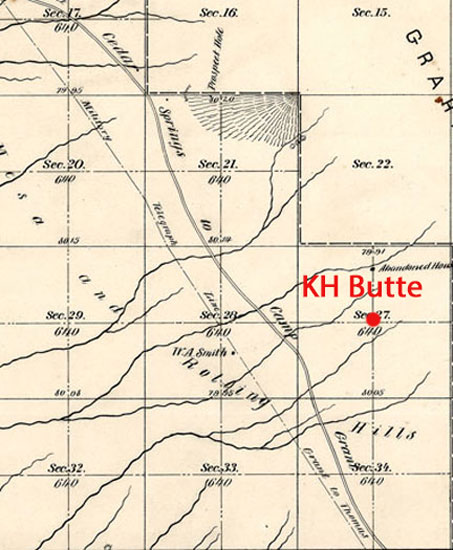 |
The army units were able to resist the initial attack and after an hour or so of fighting, the Apaches were forced to retreat. The instensity of the battle eased off a bit while the Apaches withdrew to KH Butte and other ridges east of there. During the lull in the fighting, the soldiers were able to advance. Long distance shots were then exchanged until well after dark. At around 8:30pm, the Apaches slipped away into the Graham Mountains to the north. The army units recorded one fatality, a Sergeant Buford. The Apaches, apparently, suffered no deaths.
After the conflict, the knowledge that the battle had occurred at KH Butte was "lost". Until the site was re-discovered in 1984, the history of the incident had become that the battle had occurred at Battle Mountain, a peak several miles to the southeast of KH Butte.
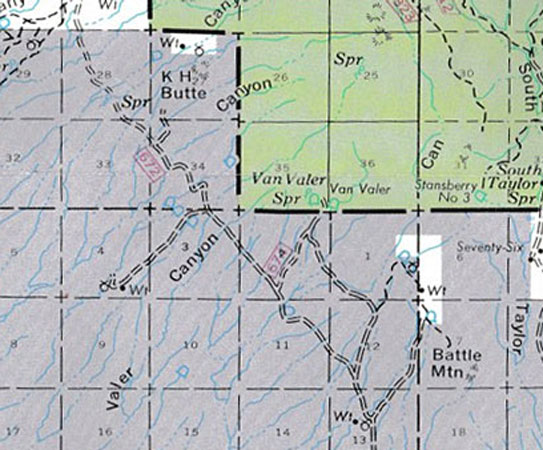 |
Soon after the re-discovery of the KH Butte battle site, an archaeological suvey of the area was done. The use of metal detectors was very important to the outcome of the project. At the time, the researchers thought that the site was still pretty much intact. Many relics associated with the battle were found on the surface. More than 1000 artifacts were eventually located, cataloged, and collected. Recovered items included buttons, buckles, a spur, and over 900 expended and loaded cartridges from several different kinds of weapons.
In 1993, Larry Ludwig and James Stute published "The Battle At KH Butte". The authors combined the knowledge gained in the archaeological study together with several historical accounts of the battle to provide a more complete description of the event. The information that I have of the battle is from this book.
Described in the Ludwig and Stute book were "features" that had been discovered during the survey of the battle site. The features included 20 fortifications, 13 of which had been put up by the Apaches. The other seven were constructed by the army.
The upper slopes of KH Butte, a hill east of there, and a ridge named Quartz Mountain were three locations used by the Apaches in the later stages of the battle. These positions had been defended so well that the soldiers had not been able to penetrate to them. On a recent walk through the area, I headed to those ridgelines first to see what I could find. From there, I dropped down to several sites known to have been used by the Army.
Fortifications constructed of one or two courses of stacked stones were dubbed "rifle pits". Shooters would lie prone behind the low walls. These photos are of Apache rifle pits that overlooked the areas below KH Butte to the west and northwest. Early in the battle, the Apaches had a contingent of warriors stationed on a low ridge west of the Butte. The army was successful in driving those warriors away. Perhaps these rifle pits were used to rain fire down onto those soldiers and keep them at bay.
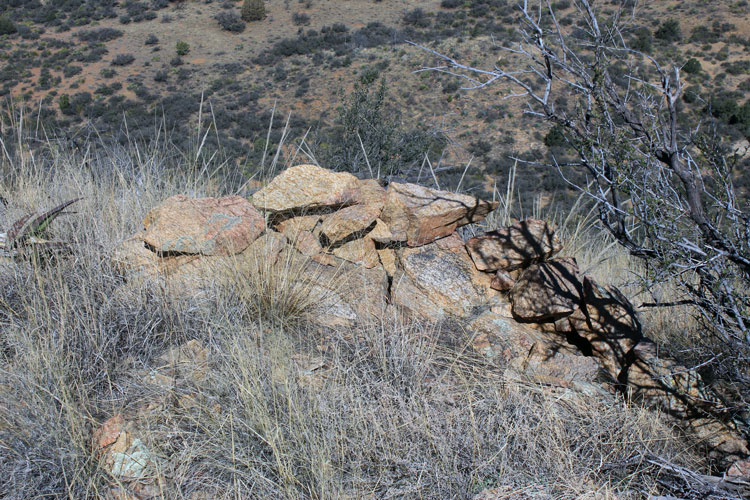 |
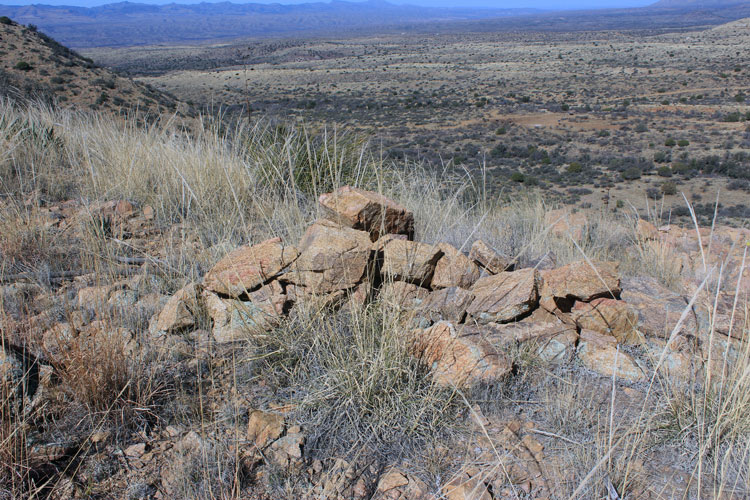 |
An observer at this position would have had a long range view to the west. The distant mountains to the right are the Santa Teresa Mountains. Any military traffic approaching from Fort Thomas would have been very visible when they turned around the nearer point of land.
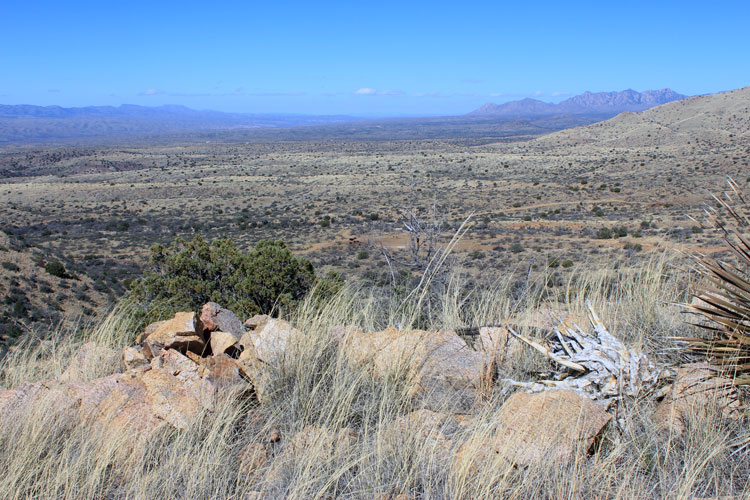 |
Another type of fortification constructed by the Apaches was made up of stones placed on the tops of larger boulders. These fortifications provided head protection for kneeling or standing shooters.
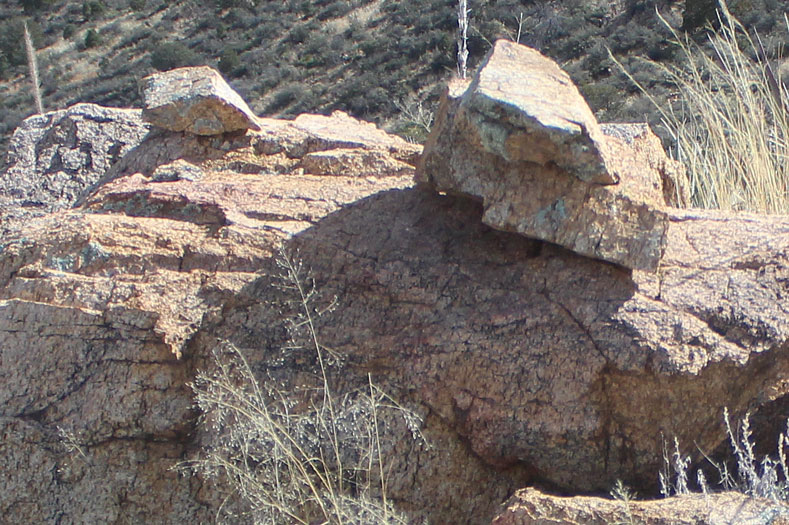 |
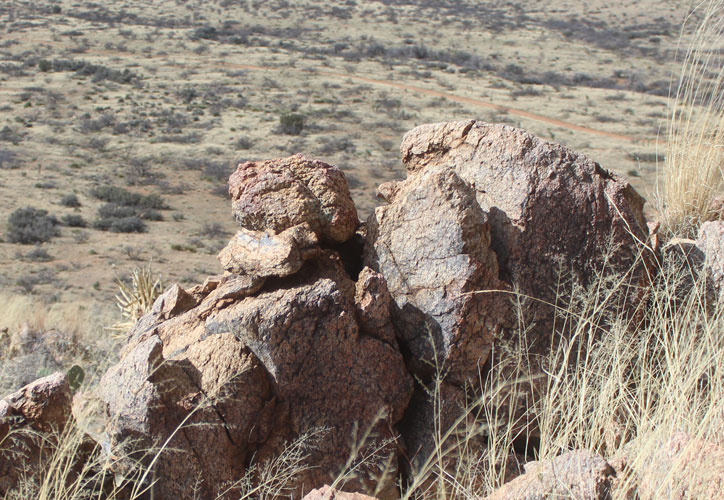 |
KH Butte at over 5000' in elevation is the dominant landmark in the area. There are commanding views in all directions from its summit. This view is across a large "flat" area to the southwest of the butte. The Aravaipa Valley and the Galiuro Mountains are in the distance. It was out there on the flats that the Apaches made their initial attack on the calvary units. After an hour or so of fighting, the Apaches retreated to the upper elevations here on KH Butte and the other hills nearby. These positions were so much more defendable.
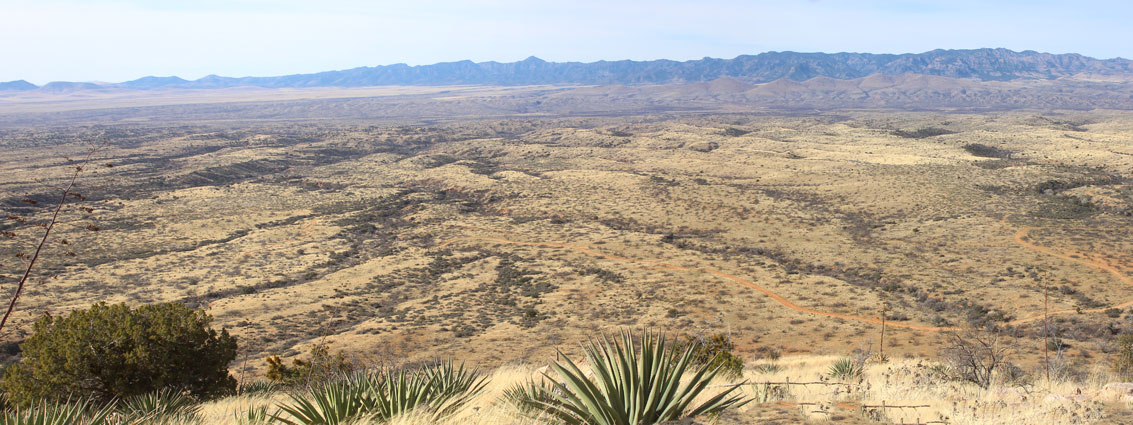 |
This is one of the rifle pits on KH Butte. It has a modern feature associated with it. Tucked away in the rocks is a glass jar with several sheets of loose paper. These are a register for visitors to the area. There are not a lot of signatures. Several date back to the mid 1990's.
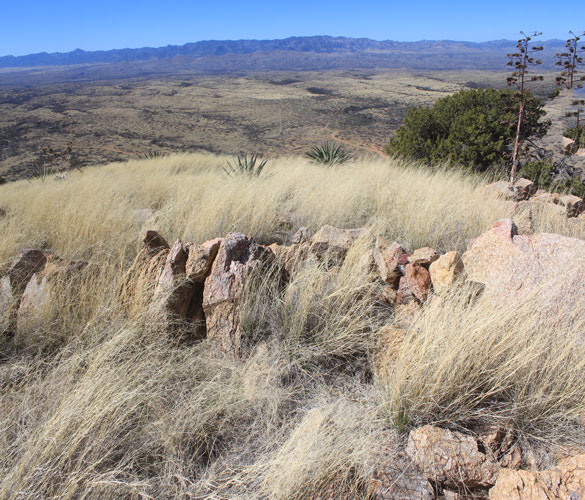 |
The register jar with its cover stone temporarily set aside.
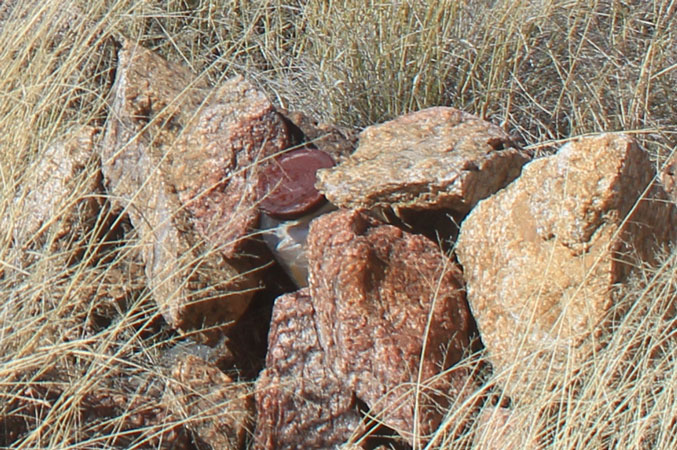 |
85% of the cartridges recovered from the Apaches' positions were 45 caliber rounds manufactured for the single shot 1873 Springfield trapdoor rifle. Slightly more than 1/2 were loaded as 45-55 shells for the carbine version of the gun. The remainder were loaded for the 45-70 rifle version. The majority of the cartridges were manufactured by civilian contract companies. This was determined by information stamped into the heads of the cartridges.
The second most common caliber of ammunition recovered was chambered for the 1866 Springfield rifle in the 50-70 caliber. Eight 44-40 caliber rounds were also found. Those had been manufactured for the early Winchester repeating rifles.
Prior to the attack on the telegraph repair crew and the calvary units, the Apaches had wiped out a wagon train near Cedar Springs Station which was several miles northwest of KH Butte. In addition to the six teamsters that were murdered, the wagons had been ransacked. and the teamsters' weapons had been stolen.
The sight lines from several of the upper positions of the Apaches seem to point to a couple of rocky knolls east of KH Butte. The location of those knolls are marked in blue.
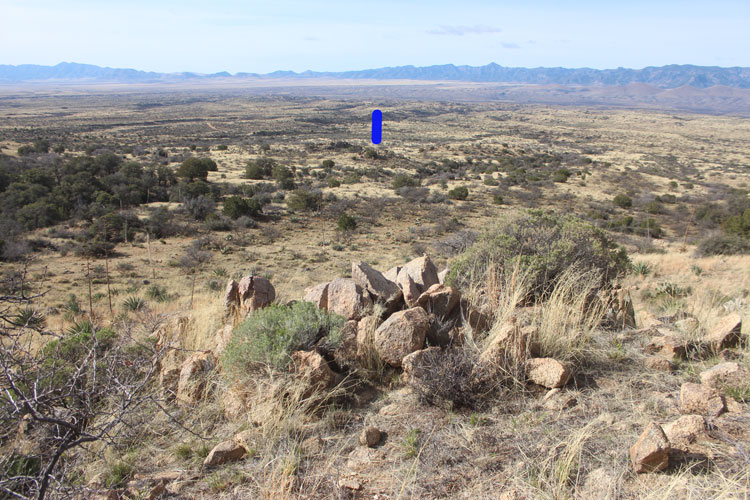 |
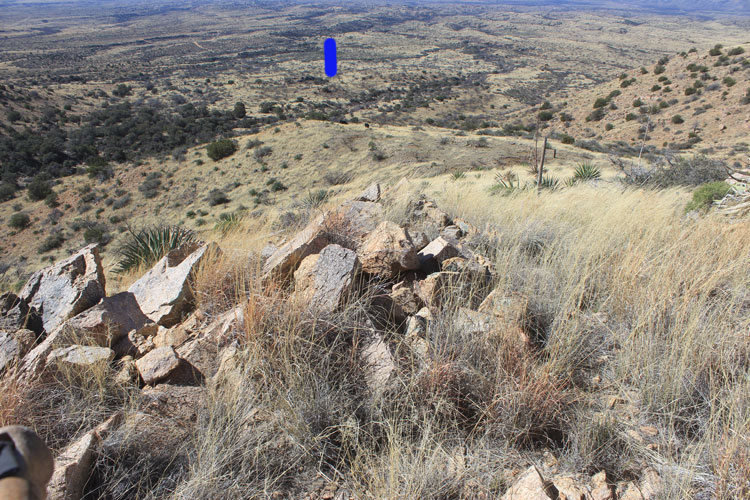 |
These are the two knolls east of KH Butte. As the Apaches retreated from their lower positions, the soliders were able to advance to these small ridgelines. The ridge on the left was named "The Breastworks" for a large fortification constructed there by the troopers.
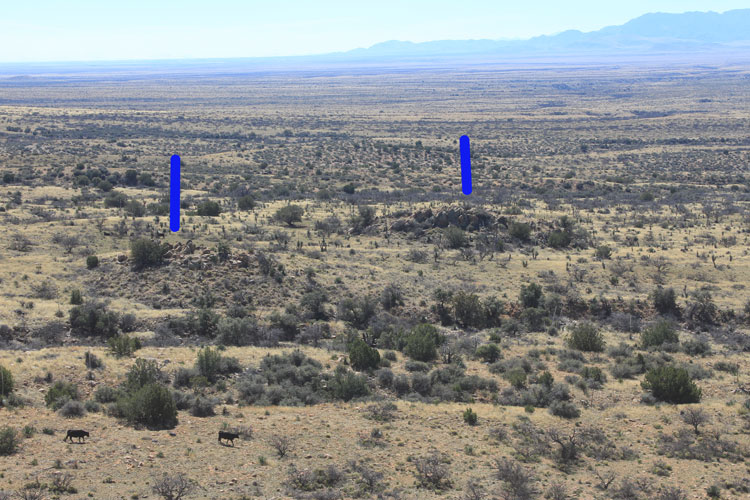 |
195 cartridge shells were collected at the Breastworks with the majority of those 45-55 carbine loads for the 1873 Springfield Trapdoor rifle, the same weapon used by the Apaches. The empty cartridges recovered here were from a different manufacturer than the ones found at the Apache sites. At the locations used by the army, the cartridge manufacturer was almost exclusively the government owned Frankford Arsenal.
These photos are from an online discussion of the history of the 45-55/45-70 caliber that appeared in a Reddit group. That discussion can be found here. The carbine loads were indistinguishable in appearance from the rifle loads. The difference was in the powder charge. The carbine shells were loaded with 55 grains of black powder, while the rifle loads contained 70 grains of powder for a greater range. The empty space in the carbine shells was filled with a paper wadding.
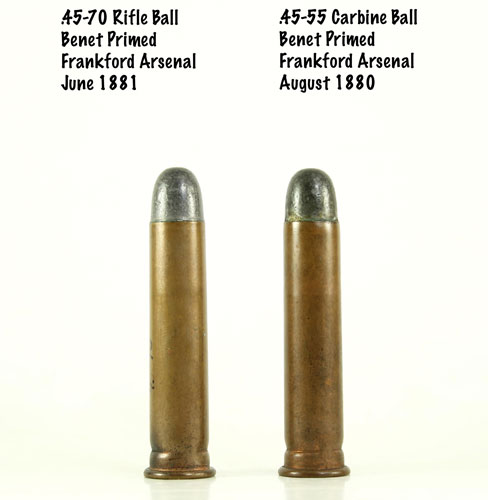 |
An important key to the interpretation of the battle was the information contained on the headstamps of the recovered cartridges. These headstamps would have been very similar to the ones found on the ammunition used by the army at KH Butte. The "F" was for Frankford Arsenal, the manufacturer of the shells. "R" designated the 45-70 rifle cartridge, while the "C" indicated the 45-55 carbine load. The rifle load in the photo was manufactured in June of 1881. The carbine load was manufactured in August of 1880. The rifle cartridge would have been too new to have been used in the KH battle. Apparently, ammunition did not make it into the field so soon after manufacture. Earlier dates of the rifle cartridges were used at KH Butte, but a surprisingly few were recovered. For some reason, that rifle ammo was not as popular as the carbine version.
According to a table in the Ludwig & Stute book, eight carbine cartridges marked identically to the one in this photo were found at the KH Battle site. The ammunition produced at the Frankford Arsenal was all internally primed as illustrated here--no visible primer. That would have made them very distinguisable from the majority of the 45 caliber ammunition used by the Apaches. Their civilian contractor produced cartridges were externally primed. The headstamps of those shells would have looked very similar to the modern center fire shells that have a visible primer.
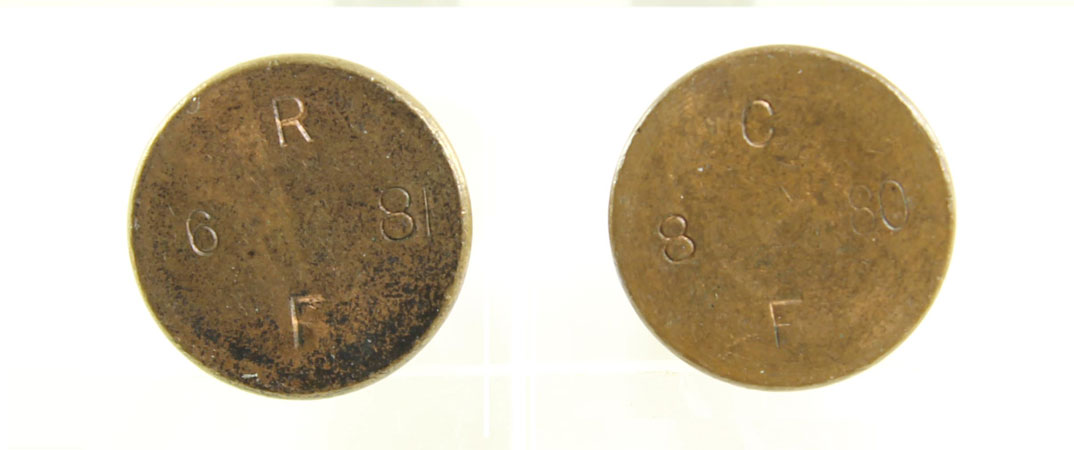 |
This view of the 2' x 4' breastworks fortification shows KH Butte in the distance. How were the troopers able to construct this with the Apaches aiming down on them? Possible explanations are that it was constructed after sundown, or perhaps the Apaches had moved on to other positions further to the north or east.
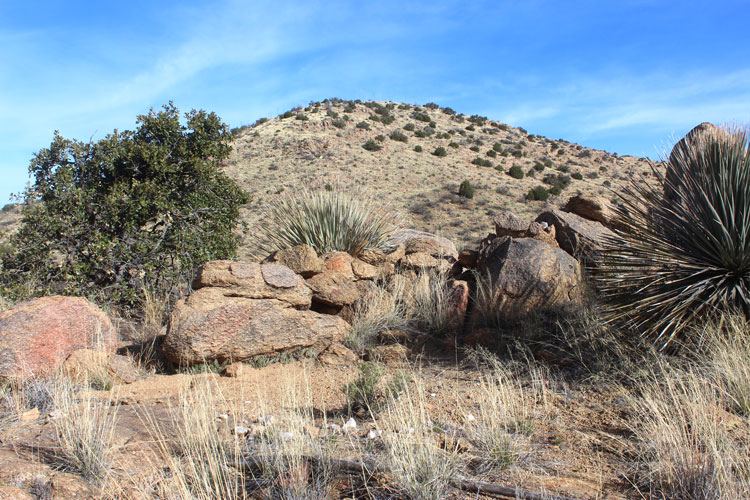 |
Other fortifications at the Breastworks knoll indicate that the soldiers were also concerned with shots coming from a hill to the east that was named Quartz Mountain. In each of the next two photos, Quartz Mountain is the hill visible beyond the fortifications.
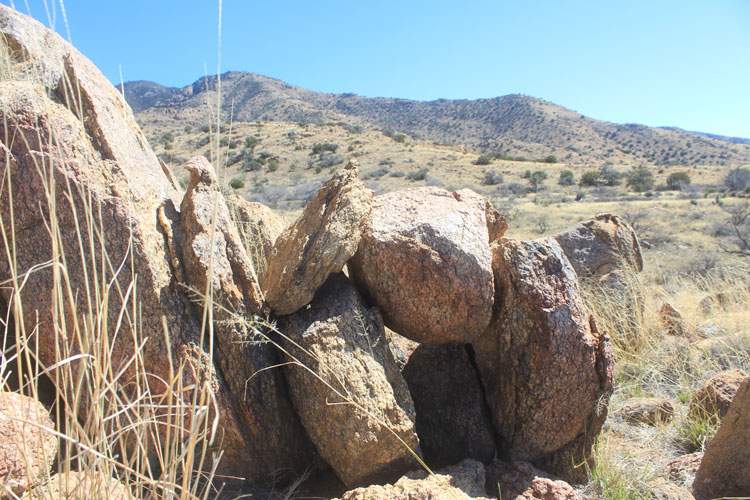 |
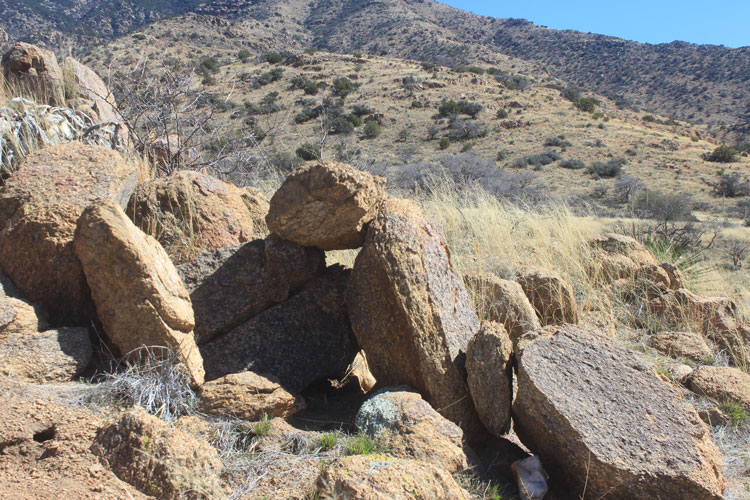 |
This Google Earth view shows the relationship between the final Apache firing positions marked in red and those of the Army marked in blue. Horseshoes and muleshoes were found on the south side of the knoll called Soldier Ridge. Apparently, the soliders had been able to move some of their animals into this position. Empty shells found along the drainages leading to the knolls indicate that the soldiers made their advance up through those channelways. More than 100 cartridges were found in one of those drainages. Spur Ridge got its name from a calvary spur that was found there by the metal detectors.
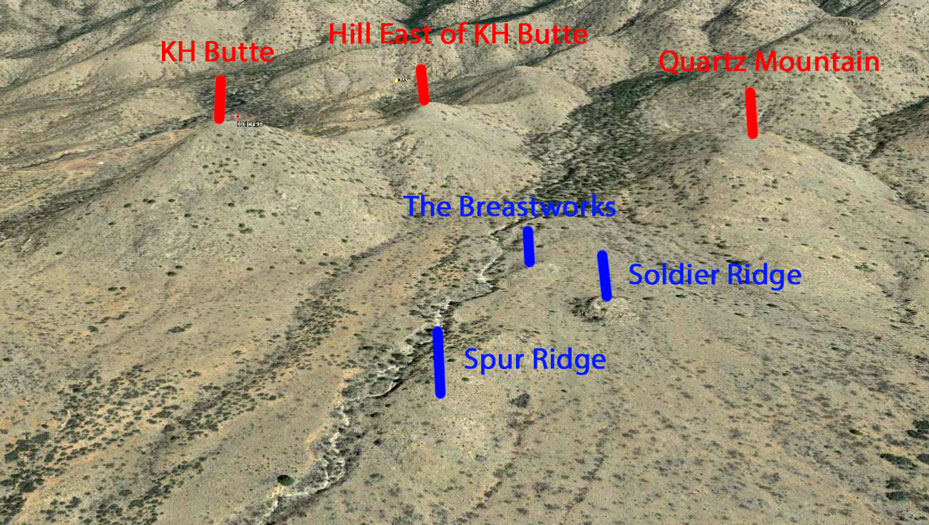 |
The soldiers arrived at the rocky ridges from an area south and southwest of KH Butte. It would have been a view similar to this that the soldiers would have had while on those flats. There does not appear to have been a lot of "bulletproof" cover available. There may have been a different turn to the battle if there had not been the shallow drainages available for the soldiers to duck into.
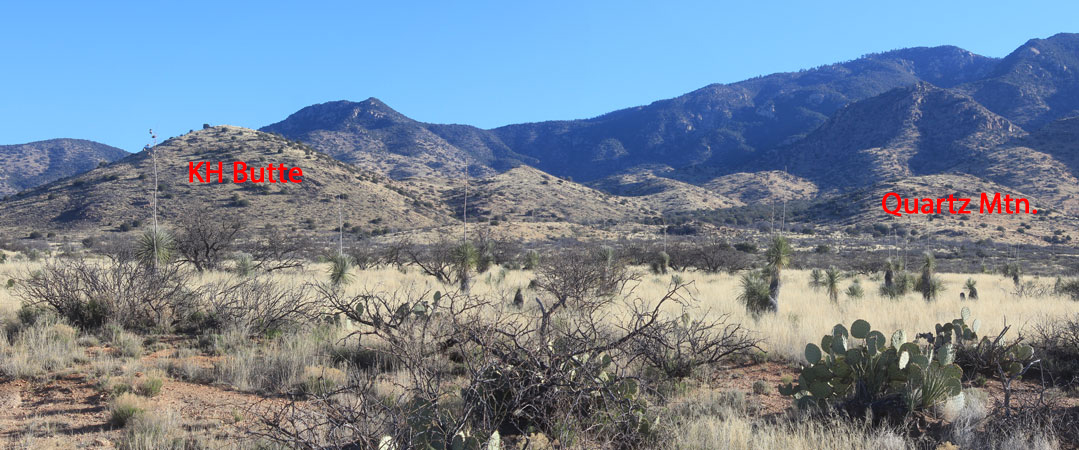 |
Over 900 cartridges were recovered at the KH Battle site. Researchers were left thinking that this was way too low. The historical accounts associated with the battle had noted that an ammunition shortage was a real concern for the soldiers. Each of the 110 to 120 soldiers had been assigned 60 rounds. If only 2/3 of the available ammuniton had been used, there would have been over 4,000 rounds fired. Where were the missing rounds? One thought was that the battle actually began further away from the KH area and that was where the missing ammunition might be found. Ludwig and Stute do not mention that any search was made to verify that idea.
Around 8:30pm on the day of the battle, the soldiers realized that the Apaches were no longer in the area. At 9pm, the troops began to gather up their dead(the one soldier killed in the battle and the four bodies of the telegraph crew), the wounded, and materials abandoned by the Apaches. The units were on the road to Fort Grant by 10 pm. I checked an online website that reports the phase of the moon for any date. On the day of the battle, the moon was 80% full. It seems that the evening sky was fairly bright. Perhaps that was what allowed the soldiers to be able to function so late into the evening.
What happened after the battle? The next day, other soldiers took up the pursuit of the Apaches. There was a battle in the Dragoon Mountains. The Apaches eventually made it to Mexico. It would be several years before this cycle of conflicts would end.
This newspaper article from those times provides a brief summary. The names of the privates killed were the members of the telegraph repair crew. A dispute between the Apaches and the Colonel Biddle mentioned in the article is thought to have been a major reason for the Apaches' flight from the reservation. Apparently, from this newspaper article, the colonel was thought to have been at fault.....
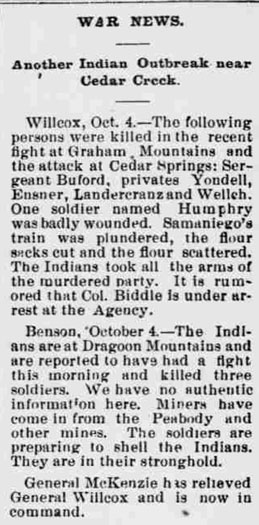 |